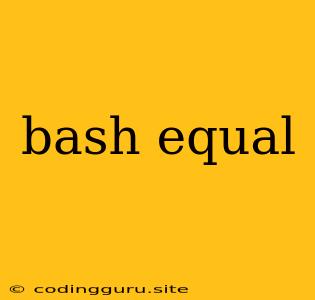Understanding and Utilizing Bash Equality Operators
In the realm of scripting and automation, Bash commands are indispensable tools. Bash, the Bourne Again Shell, is a powerful command-line interpreter that allows you to interact with your operating system efficiently. One of its key functionalities is comparing values, which is achieved through equality operators.
This article delves into the world of Bash equality operators, providing a comprehensive understanding of their usage and applications. We will explore various scenarios where equality operators are employed to make your Bash scripts more dynamic and robust.
What are Bash Equality Operators?
Equality operators are a fundamental aspect of Bash scripting that enable you to compare values. They allow you to determine if two expressions are equal or not, thus forming the basis for conditional statements and decision-making within your scripts.
Types of Equality Operators
Bash offers two primary equality operators:
-
"==" (Equal to): This operator checks if two expressions have the same value. It performs a case-sensitive comparison.
-
"!=" (Not equal to): This operator checks if two expressions have different values. It also performs a case-sensitive comparison.
Illustrative Examples
Let's look at some examples to clarify the usage of these equality operators:
Example 1: Checking for String Equality
#!/bin/bash
string1="Hello"
string2="Hello"
if [[ $string1 == $string2 ]]; then
echo "The strings are equal."
else
echo "The strings are not equal."
fi
In this example, we define two variables, string1 and string2, both assigned the value "Hello". The if statement uses the "==" operator to compare the two strings. Since they are equal, the script outputs "The strings are equal."
Example 2: Comparing Numerical Values
#!/bin/bash
number1=10
number2=15
if [[ $number1 != $number2 ]]; then
echo "The numbers are not equal."
else
echo "The numbers are equal."
fi
Here, we assign numerical values to number1 and number2. The "!=" operator is used in the if statement to check if the numbers are not equal. As they are different, the output will be "The numbers are not equal."
Case-Sensitivity Matters
It's crucial to understand that Bash equality operators are case-sensitive. This means that "Hello" and "hello" are considered different values. If you need to perform a case-insensitive comparison, you can utilize additional commands like tr or grep -i.
Applications of Equality Operators
Equality operators are widely used in various contexts within Bash scripting:
-
Conditional Statements: They are essential for controlling the flow of your scripts based on comparisons between values.
-
Loops: They can be used to iterate through lists or files, stopping at specific values or conditions.
-
Error Handling: They enable you to check for errors or unexpected situations and handle them gracefully.
-
Data Validation: You can employ them to verify user input, ensuring it meets specific criteria.
Tips for Using Equality Operators Effectively
-
Consistent Formatting: Maintain consistent spacing and indentation within your scripts for readability and maintainability.
-
Clarity Over Complicated Expressions: Break down complex comparisons into simpler ones for better understanding.
-
Utilize Comments: Add comments to explain the logic behind your comparisons, making your script easier to understand and debug.
-
Test Thoroughly: Run your scripts with different input values and edge cases to ensure your comparisons function correctly.
Conclusion
Bash equality operators are an integral part of effective Bash scripting. Understanding their functionality and applying them strategically can enhance the efficiency and robustness of your scripts. By mastering these operators, you can create dynamic, responsive, and reliable scripts that streamline your workflow and automate repetitive tasks. Remember to always strive for clarity, consistency, and thorough testing when working with Bash equality operators.
